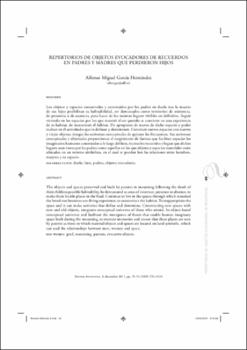Repertorios de objetos evocadores en padres y madres que perdieron hijos
Fecha
2011Resumen
Los objetos y espacios conservados y construidos por los padres en duelo tras la muerte
de sus hijos posibilitan su habitabilidad, ser demarcados como territorios de existencia,
de presencia o de ausencia, para hacer de los mismos lugares vivibles en definitiva. Seguir
viviendo en los espacios por los que transitó el ser querido se convierte en una experiencia
de re-habitar, de reconstruir el hábitat. De apropiarse de nuevo de dicho espacio y poder
realizar en él actividades que lo definan y determinen. Construir nuevos espacios con nuevos
y viejos objetos, integra los universos conceptuales de quienes los frecuentan. Sus universos
conceptuales y objetuales proporcionan el surgimiento de fuerzas que facilitan espaciar los
imaginarios humanos construidos a lo largo del luto, recrear los recuerdos y lograr que dichos
lugares sean vistos por los padres como aquellos en los que objetos y espacios materiales están
ubicados en un terreno simbólico, en el cual se pueden leer las relaciones entre hombres,
mujeres y su espacio. The objects and spaces preserved and built by parents in mourning following the death of their children possible habitability, be demarcated as areas of existence, presence or absence, to make them livable places in the final. Continue to live in the spaces through which transited the loved one becomes a re-living experience, to reconstruct the habitat. To reappropriate the space and it can make activities that define and determine. Constructing new spaces with new and old objects, integrates conceptual universes of those who attend. Its object-based conceptual universes and facilitate the emergence of forces that enable human imaginary space built during the mourning, to recreate memories and ensure that these places are seen by parents as those in which material objects and spaces are located on land symbolic, which can read the relationships between men, women and space.






